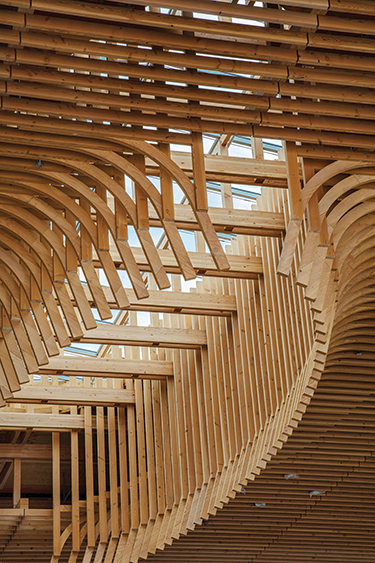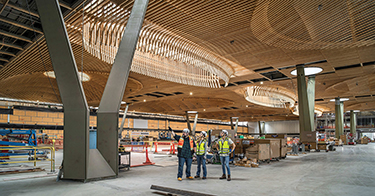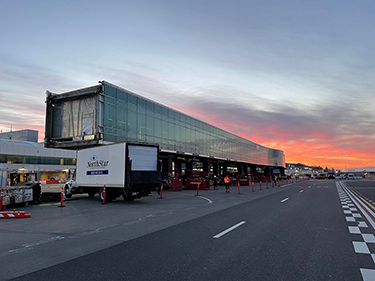|
Subscribe / Renew |
|
|
Contact Us |
|
| ► Subscribe to our Free Weekly Newsletter | |
| home | Welcome, sign in or click here to subscribe. | login |
Environment
| |
 |
April 25, 2024
Creativity and innovation are hallmarks of sustainability at PDX Airport
Skanska USA

Schneider
|

Clem
|
When the Port of Portland began its transformative renovation and expansion of Portland International Airport (PDX) in 2020, it sought partners who could do the work and be willing to develop new methods, source in new ways, and not settle for business as usual. In short, they wanted partners who could do something groundbreaking while physically and literally breaking ground.
PDX selected the joint venture (JV) team of Hoffman Skanska as the general contractor/construction manager for the project. From the beginning, creative thinking and innovation have been the expectation of every member of the team, especially when it comes to driving sustainability.
As our work continues at PDX and while there is much to be proud of over the past four years, here are three pieces of creative thinking and innovation that stand out for their massive impact on the sustainability of this project:
REDUCING EMBODIED CARBON, REVITALIZING LOCAL TIMBER
The short version is we built a nearly nine-acre mass timber roof a mile away from its final destination, trucked it over in sections before assembling it, and the result was not only visually stunning but also an 18 percent reduction in carbon vs. a steel roof. But that doesn’t begin to tell the full story.
The longer version is that the visual centerpiece of the remodeled airport is a gorgeous new 400,000 square foot mass timber roof made of 2.6 million board feet of timber from responsibly managed forests. That’s nearly nine-acres made mostly of Douglas Fir from local forests — on public, private and Tribal lands — where the Port can say with confidence where all the wood came from. That’s cutting-edge stuff.
To do that, the project team created new procurement processes to ensure the Port’s sustainable wood requirements were being met and used third-party certification of environmental stewardship when full tracking of the timber wasn’t an option. We worked with forest owners, Tribal members, loggers, mill workers and others throughout the sourcing process, creating a supply chain model that didn’t originally exist. We even kept wood separate at the sawmill so that provenance could be tracked.
By sourcing the wood regionally, there were fewer vehicle miles traveled during transport and we were able to keep more budget dollars with local logging companies and other businesses. Local industry also helped with innovation in the form of a sheathing known as mass plywood, which we used on top of the roof. Developed in Oregon, the plywood is made from eighth inch thick veneers which were formed into 2.5-inch-thick plywood panels that were then cut and shaped to fit the curved surface of the roof.
This work helped create jobs and revitalize the logging town of Lyons, once again fueling pride in an industry that has played a large role in the Pacific Northwest for decades.
REUSING CONNECTOR SAVED WASTE, CARBON, TIME AND MONEY
To make room for all the construction happening at PDX, the Concourse Connector — a 700-foot-long, 18,000-ton elevated glass hallway that connected the north and south wings of the airport — was slated for demolition. But Hoffman Skanska had unique idea, to cut it in half and reuse it elsewhere, and the Port of Portland was fully supportive.
After moving the two halves into their new positions (a massive feat alone), each Concourse Connector piece found new life as a bypass to help people move safely around the construction zones within the main airport, easily separating pedestrian traffic from construction activity.
Furthermore, this circular approach to materials use eliminated waste, avoided unnecessary construction of tunnels or new walkways and the embodied carbon associated with it, and saved both time and money.
CUTTING ENERGY COSTS THROUGH UNIQUE HEATING AND COOLING
Another component of sustainability that’s key to PDX’s future operational efficiency is a unique ground-sourcing program designed to cut the airport’s use of fossil fuels by 95 percent and total energy costs by 50 percent.
Hoffman Skanska is currently drilling wells deep into the Troutdale Sandstone Aquifer that lies about 500 feet below the airport. The water will then be turned into heating and cooling energy through a heat pump system designed by local engineering firm PAE. Once run through the heat exchangers, the water will be sent back down below the surface, completing this closed loop without contacting anything that could contaminate the aquifer.
Since the temperature of the ground water is cooler than the air temperature during warmer months and warmer than the air temperature during cooler months, the temperature differential can help heat and cool the airport without the need for oil and natural gas like the airport currently uses. This innovative approach will provide PDX with an ongoing, sustainable and cost-saving method of conditioning its buildings.
Portland International Airport is a world class airport, not just because of its aesthetics and amenities, which are second to none, but also because of how the Port of Portland and its partners like Hoffman Skanska work together to find creative and innovative solutions to the sustainability challenges of today and tomorrow.
Joe Schneider is senior vice president and account manager, and Steve Clem is senior vice president for project planning services & sustainability at Skanska USA.
Other Stories:
- Implementing aggressive water goals
- Curbing construction’s carbon impact from all angles
- Making old buildings new again: the case for adaptive reuse
- Promoting residential adaptive reuse in Seattle through policy
- Hiding in Plain Sight: Sustainability and resilience beyond the terminal
- Reducing embodied carbon in concrete construction
- Old building, new tricks: Designing adaptive reuse for long-lasting relevance
- Harnessing the potential of mixed-use communities
- A blueprint for environmental responsibility in construction
- A primer on campus decarbonization in Washington
- Toward a path to zero carbon: building renovations and circular economy principles





